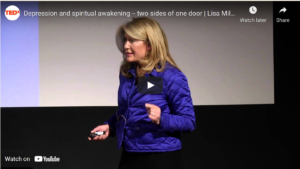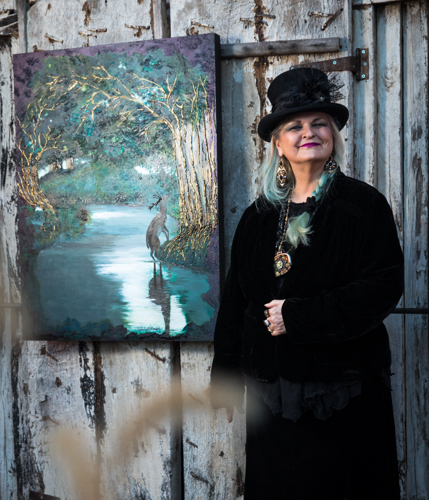The Spiritual Brain: A Road Map to Alleviating our National Mental Health Crisis
By: Lisa Miller, Ph.D.

We are living in a perfect storm of unprecedented crisis. As our country emerges from a once- in-a-generation pandemic, our servicemen and women are on high alert as Russia wages war in Ukraine, and youth struggle to socially connect with one another like never before as a result of isolation and lockdowns. Beneath the surface of these multiple crises, our country’s collective mental health is suffering.
The nation’s mental health crisis is affecting everyone, but we are seeing especially troubling data amongst our youth and young adults. Rates of despair, addiction, depression, suicide, and ER psychiatric visits reflect an all-time level of suffering. The crisis has become so alarming that America’s top doctor, U.S. Surgeon General Dr. Vivek Murthy issued a Surgeon General’s Advisory to highlight the urgent need to address the nation’s youth mental health crisis echoed by President Biden in the State of the Union.
Since the Surgeon General’s red flag, many in the mental health field have proposed solutions to the crisis – focusing on providing more access to mental health resources and creating the conditions to attract more providers to the field. And while it is true that we do not have enough providers to meet this moment, in order to solve this existential crisis facing our nation, we cannot simply replicate more of the same. Our models are incomplete and insufficient until we engage the spiritual core of youth.
Spirituality and religion are two different things. Capacity for spirituality is innate; religion is transmitted through family and community as an embrace of natural spirituality that is environmentally transmitted.
Our studies of the spiritual brain are rooted in hard science. MRI studies show specific circuits in the brain associated with spiritual awareness that grows stronger and thickens when we tap into our innate, spiritual core. The neural docking station responsible for holding and firing these circuits needs to be strengthened, much like a muscle, for young adults to be prepared to move through life’s challenges and adversity with awakened awareness. Through the use of our spiritual brain station, we perceive that we are in partnership with our Higher Power (the name changes across faith, wisdom, cultural and religious traditions), such that we feel loved, held and guided, and never alone.
Some of us are more predisposed than others to feeling spiritually connected. And how a child is engaged shapes and forms the spiritual core of their whole personhood. But we can all cultivate this natural capacity and build our spiritual muscle. While this is a relatively new science, there are now more than two decades of peer-reviewed research which shows that strong spirituality brings resilience against the diseases of despair, particularly in times of great stress or trauma, and is essential in the course of treatment for growth and renewal. It also offers prevention against feelings of hopelessness about the future. We wait until youth are in the therapist chair or bottoming out in AA, to teach that life is lived through a partnership with one’s Higher Power. Evidence from MRI studies on the spiritual brain shows that in fact, we are hard-wired to be able to “hand it over,” in times of pain, isolation, and uncertainty or to discover direction and guidance.
Research shows that a teen with strong personal spirituality is 75-80 percent less like to become addicted to drugs and alcohol, and 60-80 percent less likely to attempt suicide. The data clearly show that young people with a connection to their spiritual core are far more likely to engage character strengths and virtues such as optimism, grit, commitment, and forgiveness The science of the spiritual brain is essential to fighting back against the disease of despair. The
U.S. Army, led by Chief of Chaplains, Maj. Gen. Thomas L. Solhjem is working to bring the science of spirituality to the Army and further imbue this science into everything they do. Last year, the Army invited me to the Pentagon to speak for the top leadership including the Secretary, Chief and Vice Chief of the Army.
 This was followed by my collaboration in an intensive training at Fort Bragg, North Carolina, one of the world’s largest military installations, to talk to a group of 200 officers— including the fort’s Three Star General Commander and the Surgeon General of the Army — about the science of spirituality. The training led to a three-day pilot to bring the science of spirituality to those further down the chain of command to affect 80,000 soldiers. Since this time, together with the Army’s Chief of Chaplains Tom Solhjem and Chief of Psychiatry, Colonel Sam Preston, we have delivered the Spiritual Readiness Initiative to 12 of the leading US Army posts with its effects now reaching hundreds of thousands of soldiers. The Spiritual Readiness Initiative uses the science of spirituality and mental health as a road map to inform training, culture, and prevention and treatment of mental health to transform an institution of over a million people with another million in their care.
This was followed by my collaboration in an intensive training at Fort Bragg, North Carolina, one of the world’s largest military installations, to talk to a group of 200 officers— including the fort’s Three Star General Commander and the Surgeon General of the Army — about the science of spirituality. The training led to a three-day pilot to bring the science of spirituality to those further down the chain of command to affect 80,000 soldiers. Since this time, together with the Army’s Chief of Chaplains Tom Solhjem and Chief of Psychiatry, Colonel Sam Preston, we have delivered the Spiritual Readiness Initiative to 12 of the leading US Army posts with its effects now reaching hundreds of thousands of soldiers. The Spiritual Readiness Initiative uses the science of spirituality and mental health as a road map to inform training, culture, and prevention and treatment of mental health to transform an institution of over a million people with another million in their care.
If this approach is good enough for the U.S military as they address a drastic increase in the rates of despair of service men and women, then it could be a proven and valuable approach for high school and college students. Daily life for today’s youth can feel like basic military training focused upon accomplishment and intensive preparation for a rapidly changing battlefield that can yield potential traumas. The societal traumas facing youth outside of the Army suggest that higher education can help young adults to “build an arc before it rains,” through support of spirituality in culture, climate, language, and programs in our universities. In fact, it is time that our efforts around diversity and inclusivity include spiritual diversity, too, as we seek to understand and care for our nation’s young people.
When it comes to resilience, the deepest source of renewal, revival, and persistence is the spiritual core. It’s time to rethink how we treat our youth. Their lives depend on it.
—
 Lisa Miller, Ph.D. is a Professor at Columbia University, Teachers College, parent of three Gen Zs, and the author of The Awakened Brain; The New Science of Spirituality and Our Quest for an Inspired Life.
Lisa Miller, Ph.D. is a Professor at Columbia University, Teachers College, parent of three Gen Zs, and the author of The Awakened Brain; The New Science of Spirituality and Our Quest for an Inspired Life.
You can learn more about Dr. Lisa Miller and her book by visiting her website at www.LisaMillerPhD.com
Follow Dr. Miller on Instagram @Dr.lisamiller
Click here to buy her book on Amazon
- Welcome to the December 2024 Cover Issue of the Pulpwood Newsletter! - December 1, 2024
- New Author Members – November 2024 - December 1, 2024
- Welcome to the November 2024 Cover Issue of the Pulpwood Newsletter! - November 2, 2024
- New Author Members – October 2024 - October 31, 2024
- Welcome to the October 2024 Cover Issue of the Pulpwood Newsletter! - October 1, 2024
- Welcome to the September 2024 Cover Issue of the Pulpwood Newsletter! - September 1, 2024
- New Author Members – August 2024 - August 19, 2024
- Welcome to the August 2024 Cover Issue of the Pulpwood Newsletter! - August 5, 2024
- New Author Members – July 2024 - July 30, 2024
- Welcome to the July 2024 Cover Issue of the Pulpwood Newsletter! - July 1, 2024






